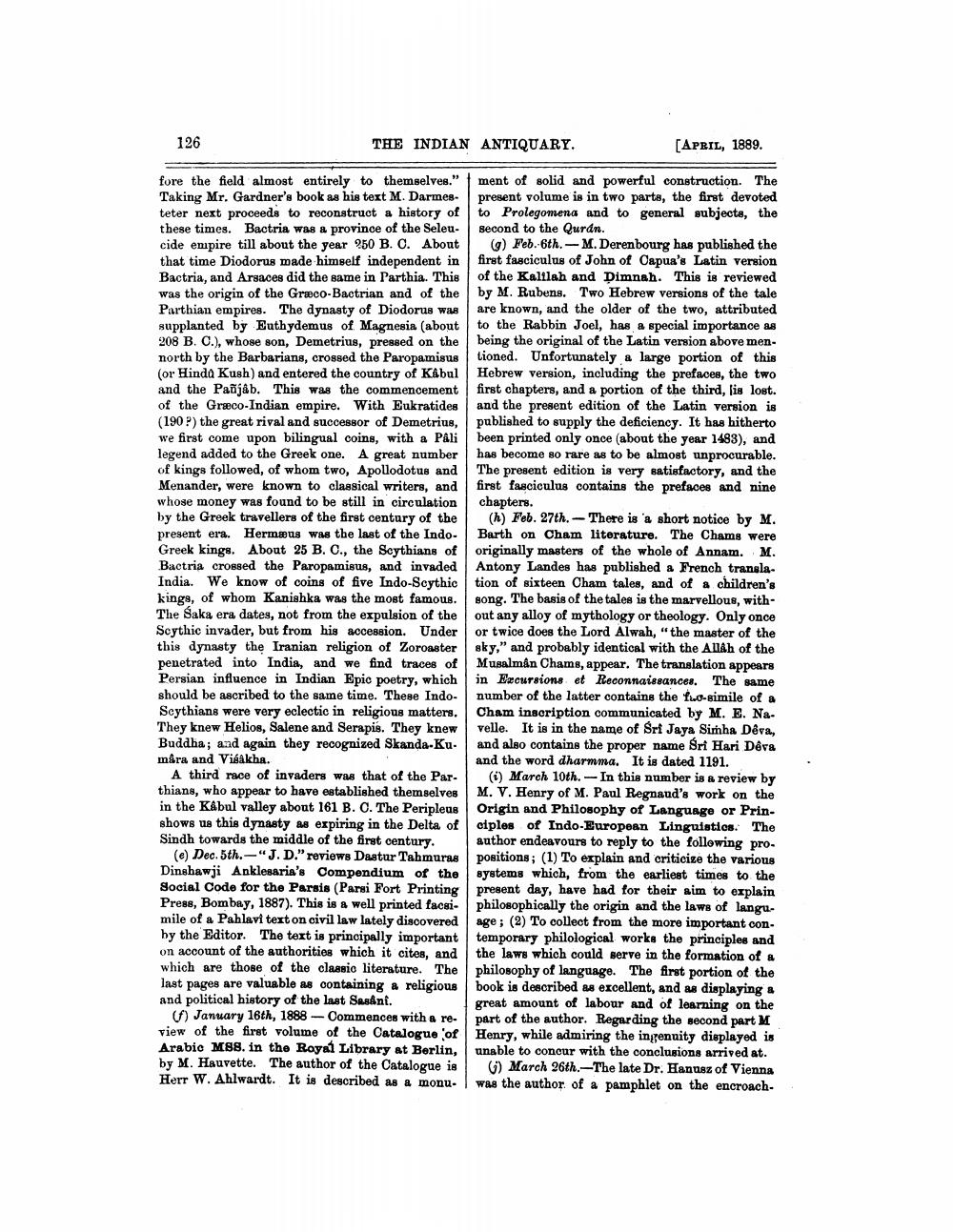________________
126
THE INDIAN ANTIQUARY.
[APRIL, 1889.
fore the field almost entirely to themselves." Taking Mr. Gardner's book as his text M. Darmeg. teter next proceeds to reconstruct a history of these times. Bactria was a province of the Seleu- cide empire till about the year 250 B. C. About that time Diodorus made himself independent in Bactria, and Arsaces did the same in Parthia. This was the origin of the Græco-Bactrian and of the Parthian empires. The dynasty of Diodorus was supplanted by Euthydemus of Magnesia (about 208 B. C.), whose son, Demetrius, pressed on the north by the Barbarians, crossed the Paropamisus (or Hinda Kush) and entered the country of Kabul and the Pañjab. This was the commencement of the Græco-Indian empire. With Eukratides (190?) the great rival and successor of Demetrius, we first come upon bilingual coins, with a Páli legend added to the Greek one. A great number of kings followed, of whom two, Apollodotus and Menander, were known to classical writers, and whose money was found to be still in circulation by the Greek travellers of the first century of the present era. Hermaus was the last of the IndoGreek kings. About 25 B. C., the Scythians of Bactria crossed the Paropamisus, and invaded India. We know of coins of five Indo-Scythic kings, of whom Kanishka was the most famous. The Saka era dates, not from the expulsion of the Scythic invader, but from his accession. Under this dynasty the Iranian religion of Zoroaster penetrated into India, and we find traces of Persian influence in Indian Epic poetry, which should be ascribed to the same time. These IndoScythians were very eclectic in religious matters. They knew Helios, Salene and Serapis. They knew Buddha; and again they recognized Skanda-Ku. mara and Visakha.
A third race of invaders was that of the Par. thians, who appear to have established themselves in the Kábul valley about 161 B. 0. The Peripleus shows us this dynasty as expiring in the Delta of Sindh towards the middle of the first century.
(e) Dec. 5th.-"J.D." reviews Dastur Tahmuras Dinshawji Anklesaria's Compendium of the Social Code for the Parsis (Parsi Fort Printing Press, Bombay, 1887). This is a well printed facsi. mile of a Pahlavi text on civil law lately discovered hy the Editor. The text is principally important on account of the authorities which it cites, and which are those of the classic literature. The last pages are valuable as containing a religious and political history of the last Sasånt.
(f) January 16th, 1888 - Commences with a review of the first volume of the Catalogue of Arabic M88. in the Royal Library at Berlin, by M. Hauvette. The author of the Catalogue is Herr W. Ahlwardt. It is described as a monu-
ment of solid and powerful construction. The present volume is in two parts, the first devoted to Prolegomena and to general subjects, the second to the Quran.
(9) Feb. 6th.-M. Derenbourg has published the first fasciculus of John of Capua's Latin version of the Kalllah and Dimnah. This is reviewed by M. Rubens. Two Hebrew versions of the tale are known, and the older of the two, attributed to the Rabbin Joel, has a special importance as being the original of the Latin version above mentioned. Unfortunately a large portion of this Hebrew version, including the prefaces, the two first chapters, and a portion of the third, is lost. and the present edition of the Latin version is published to supply the deficiency. It has hitherto been printed only once about the year 1483), and has become so rare as to be almost unprocurable. The present edition is very satisfactory, and the first fasciculus contains the prefaces and nine chapters.
(h) Feb. 27th. - There is a short notice by M. Barth on Cham literature. The Chams were originally masters of the whole of Annam. M. Antony Landes has published a French transla. tion of sixteen Cham tales, and of a children's gong. The basis of the tales is the marvellous, without any alloy of mythology or theology. Only once or twice does the Lord Alwah," the master of the sky," and probably identical with the Allah of the Musalman Chams, appear. The translation appears in Excursions et Reconnaissances. The same number of the latter contains the fac-simile of a Cham inscription communicated by M. E. Navelle. It is in the name of Sri Jaya Simha Dêra, and also contains the proper name Sri Hari Deva and the word dharmma. It is dated 1191.
(1) March 10th. In this number is a review by M. V. Henry of M. Paul Regnand's work on the Origin and Philosophy of Language or Principles of Indo-European Linguistics. The author endeavours to reply to the following propositions ; (1) To explain and criticize the various systems which, from the earliest times to the present day, have had for their aim to explain philosophically the origin and the laws of language; (2) To collect from the more important contemporary philological works the principles and the laws which could serve in the formation of a philosophy of language. The first portion of the book is described as excellent, and as displaying a great amount of labour and of learning on the part of the author. Regarding the second part M Henry, while admiring the ingenuity displayed is unable to concur with the conclusions arrived at.
6) March 26th. --The late Dr. Hanusz of Vienna was the author of a pamphlet on the encroach.




